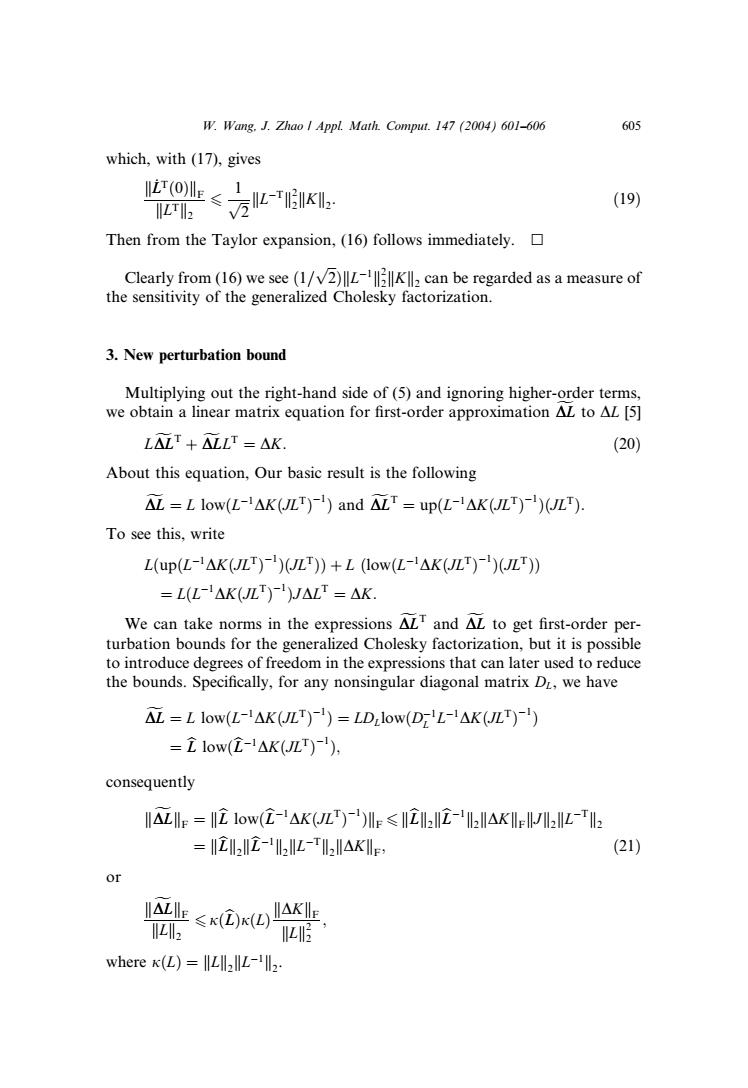正在加载图片...

W.Wang.J.Zhao Appl.Math.Comput.147 (2004)601-606 605 which,with(17),gives 器s方上guL: (19) Then from the Taylor expansion,(16)follows immediately. Clearly from(16)we see (1/v2)2 can be regarded as a measure of the sensitivity of the generalized Cholesky factorization. 3.New perturbation bound Multiplying out the right-hand side of(5)and ignoring higher-order terms, we obtain a linear matrix equation for first-order approximation AL to AL [5] LLT+LLT=△K, (20) About this equation,Our basic result is the following L=Llow(L-1△KJL)-)andL=up(L-1△KJL)-)JLT) To see this,write L(up(L-AK(JLT))(JLT))+L (low(L-AK(JLT))(LT)) =L(L-1△K(JULT)-JALT=△K. We can take norms in the expressions ALT and AL to get first-order per- turbation bounds for the generalized Cholesky factorization,but it is possible to introduce degrees of freedom in the expressions that can later used to reduce the bounds.Specifically,for any nonsingular diagonal matrix D,we have L=Llow(L-l△K(LT)-)=LDLlow(DL-1△K(JLT)) =立low(亿-1△K(JLT)-), consequently I△LlEe=Zlow(亿-△KJL)-Ie≤IZIl2Z-2ll△K2IZ-TIl2 =L-TI2MAKIlE (21) 01 Haa路 IZ2 where (L)=2-.which, with (17), gives kL_ Tð0ÞkF kLTk2 6 1 ffiffiffi 2 p kLTk 2 2kKk2: ð19Þ Then from the Taylor expansion, (16) follows immediately. Clearly from (16) we see ð1= ffiffiffi 2 p ÞkL1k2 2kKk2 can be regarded as a measure of the sensitivity of the generalized Cholesky factorization. 3. New perturbation bound Multiplying out the right-hand side of (5) and ignoring higher-order terms, we obtain a linear matrix equation for first-order approximation D fL to DL [5] LD fLT þ D fLLT ¼ DK: ð20Þ About this equation, Our basic result is the following D fL ¼ L lowðL1 DKðJLTÞ 1 Þ and D fLT ¼ upðL1 DKðJLTÞ 1 ÞðJLTÞ: To see this, write LðupðL1 DKðJLTÞ 1 ÞðJLTÞÞ þ L ðlowðL1 DKðJLTÞ 1 ÞðJLTÞÞ ¼ LðL1 DKðJLTÞ 1 ÞJDLT ¼ DK: We can take norms in the expressions D fLT and D fL to get first-order perturbation bounds for the generalized Cholesky factorization, but it is possible to introduce degrees of freedom in the expressions that can later used to reduce the bounds. Specifically, for any nonsingular diagonal matrix DL, we have D fL ¼ L lowðL1 DKðJLTÞ 1 Þ ¼ LDLlowðD1 L L1 DKðJLTÞ 1 Þ ¼ bL lowðbL1 DKðJLTÞ 1 Þ; consequently kD fLkF ¼ kbL lowðbL1 DKðJLTÞ 1 ÞkF 6 kbLk2kbL1 k2kDKkFkJk2kLTk2 ¼ kbLk2kbL1 k2kLTk2kDKkF; ð21Þ or kD fLkF kLk2 6 jðbLÞjðLÞ kDKkF kLk 2 2 ; where jðLÞ¼kLk2kL1k2. W. Wang, J. Zhao / Appl. Math. Comput. 147 (2004) 601–606 605